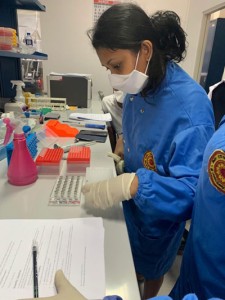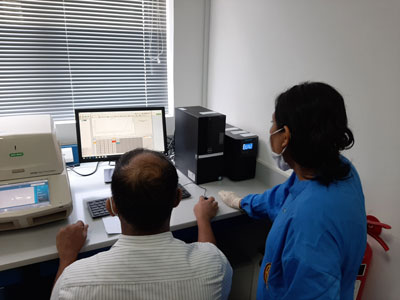News
Sri Lanka has A-type new coronavirus

Prof. Neelika Malavige
It had never been done before in Sri Lanka and from the time they tested the samples of the first local confirmed case of COVID-19, a small research team was raring to go.
Excited, the team from the Faculty of Medical Sciences at the University of Sri Jayewardenepura may have been, but they had to hold their horses for a month. The team led by Prof. Neelika Malavige and comprising Dr. Chandima Jeewandara and other research scientists are attached to the state-of-the-art Centre for Dengue Research at the Allergy, Immunology and Cell Biology Unit.
On April 12, they were able to do what they had been waiting for – the Whole Genome Sequencing (WGS) of a virus never done before in this country…….and this was not just of any virus but the new coronavirus (SARS-CoV2).
“We tested the sample from the first local (the tour guide) to get COVID-19 on March 10 and when it was positive we ordered the reagents needed to do the WGS the next day itself, but had to await a month due to flight issues,” says Prof. Malavige, explaining how very willingly the Sri Lankan High Commissioner in Singapore, Sashikala Premawardhane intervened to send the reagents as “diplomatic cargo”.
Appreciative of this major gesture, she says that her team immediately got to work as the university had earlier secured an Illumina sequencer.
 Before getting down to the nitty-gritty of the technicalities, Prof. Malavige says that the world got wind properly of a new virus that had jumped from an animal species (the pangolin-bat link has still not been concretely determined) to humans in January. In the initial stages itself, this RNA (ribonucleic acid) virus had undergone rapid mutation (an alteration in the nucleotide sequence of its genome), forming three different clades (a clade is a group of organisms that has a common ancestor) which had been found by scientists across the world, she said, explaining that the clades are A, B & C. Asking why we should ascertain whether there has been a mutation of a virus and what clade of that particular virus is circulating in a specific environment, Dr. Malavige replies: Some believe that certain clades of the same virus could be more virulent or less virulent than others which would determine whether there would be high or low mortality (deaths) and morbidity (illness).
Before getting down to the nitty-gritty of the technicalities, Prof. Malavige says that the world got wind properly of a new virus that had jumped from an animal species (the pangolin-bat link has still not been concretely determined) to humans in January. In the initial stages itself, this RNA (ribonucleic acid) virus had undergone rapid mutation (an alteration in the nucleotide sequence of its genome), forming three different clades (a clade is a group of organisms that has a common ancestor) which had been found by scientists across the world, she said, explaining that the clades are A, B & C. Asking why we should ascertain whether there has been a mutation of a virus and what clade of that particular virus is circulating in a specific environment, Dr. Malavige replies: Some believe that certain clades of the same virus could be more virulent or less virulent than others which would determine whether there would be high or low mortality (deaths) and morbidity (illness).
There is speculation that the clade circulating in Malaysia, Thailand and India is less virulent than the one doing the rounds in Europe and the east coast of America. · As various potential vaccines are in the pipeline, it would be good to know what clade is in a particular country before committing to take a vaccine which may be against a different clade. · We also want to know how the virus attaches itself to the receptor cell because that determines the disease severity, whether mild or virulent. This is why WGS which is sequencing the complete nucleotide pattern of the virus is done, it is learnt. “As a start, we performed WGS on the samples of four patients who tested positive for COVID-19,” says Prof. Malavige. The team has deposited the sequence identification in the Gene Bank and GISAID, which are open-source resources so that the WGS of the new coronavirus in Sri Lanka would be available globally for analysis to check out the evolution of the virus.
With samples being sent overseas earlier whenever Sri Lanka required WGS, many are of the view that the team’s work is a major achievement for Sri Lanka.

| J’pura team to conduct WGS on 20 more samples next week What did the Whole Genome Sequencing of the RNA from the samples of four Sri Lankans who tested positive for COVID-19 find? The viruses tested from all four patients were found to be a sub-type of the A Clade, says Prof. Neelika Malavige, explaining that it is seen in Australia, certain parts of India and the west coast of America. Even though the initial clade in China had predominantly been a sub-type of the A Clade, now it is the B Clade that is found there, as also in Taiwan and South Korea. In Europe it is predominantly the C Clade. Prof. Malavige says that we cannot jump to conclusions with just four virus samples and that is why they are hoping to test another 20 samples next week, laughingly adding that it is easy to extract the RNA and sequence it with the laboratory’s Illumina but it is very time-consuming to carry out the data analysis. | |


